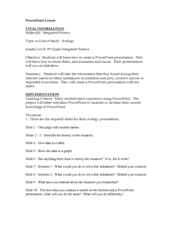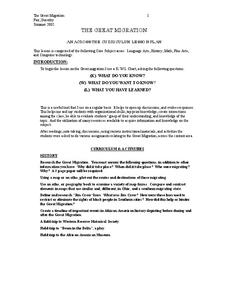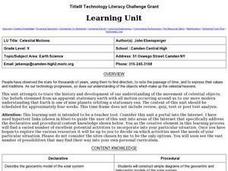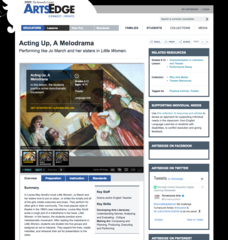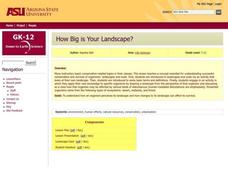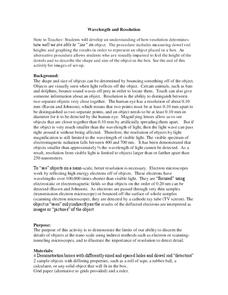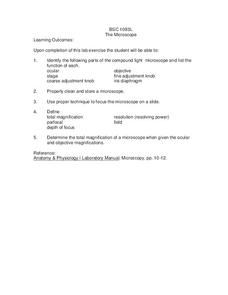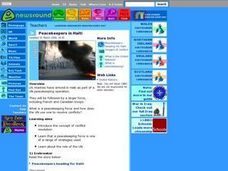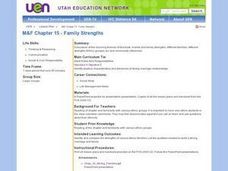Curated OER
Game Plans
Students consider the online game Neopets as a springboard to developing the characters, settings and plots for online fantasy games. They draft technical plans that describe how their games be presented and played on the We
Curated OER
Ecology
Students personify ecology vocabulary and write a one-act play using their knowledge of ecology as the basis for characters, conflict, setting and plot.
Curated OER
Writing a Children's Book -- Young Authors
High schoolers practice their writing skills by creating a children's book. They integrate five elements of short stories into the narrative. They share their stories with their book buddies.
Curated OER
An Occurrence at Owl Creek Bridge LP
Pupils engage in a reading of literature with the intention of working on the reading comprehension skill of identifying the plot of a story. They conduct independent reading looking for the plot and fill in the graphic organizer for...
Curated OER
The Great Migration
Young scholars research the Great Migration and answer questions to discover where it took place, when it took place, who were migrating, and why in a 2 page paper. They use a map or atlas to plot out the routes and destinations of those...
Curated OER
History/Mystery: Regionalism and Ethnicity in the American Detective Novel
Students use mystery novels to focus on the history and ethnicity of different regions of the United States. As a class, they are introduced to the elements of a mystery and compare them to the other types of novels they have read. In...
Curated OER
Celestial Motions
Ninth graders complete a unit of lessons on the history of our knowledge of celestial objects. They conduct Internet research, plot the motion of a planet, construct a model of the sun's apparent motions, and create diagrams of the solar...
Curated OER
Evaluate Problem-Solving in the Context of Culture and Time-frame
Students examine literary elements in non-fiction literature. In this problem solving lesson, students read Rosa Parks, My Story and Beyond the Limits. Students make oral presentations based on the causes and effects, conflicts, and...
John F. Kennedy Center
Acting Up, A Melodrama: Performing Like Jo March and Her Sisters in Little Women
Lights, Camera, Action! Pupils read Little Women and create, act, and direct a melodrama that Jo March and her sisters would enjoy. The lesson plan comes complete with resources for the educator on melodrama as well as examples...
Curated OER
Camera Movement
High schoolers focus on different ways director and cinematographers use the camera to convey meaning, setting, tone, point of view, personal style, as well as telling a story.
Curated OER
Literature: Mapping the Mockingbird
Students read Harper Lee's To Kill a Mockingbird, focusing on setting. They list items that create mental images of the novel's setting along with location references to characters and events. Using posterboard, they construct physical...
Curated OER
Multimedia Final Project
Young scholars work with a partner to compile a new movie. They comprehend tat the movie requres a lot of preparation and media releases. Students use one computer, create the serval different materials for their film: A Publisher...
Curated OER
How Big Is Your Landscape?
Students explore how an organism perceives its landscape and how changes to its landscape can effect its survival. Of particular focus is the effect of urbanization and the organisms survival in the cities.
Curated OER
Debate: Oregon's Death with Dignity Act
Students hold formal debate on the Death with Dignity Act. After researching information in the library, they record it on index cards. They prepare construction, cross examination, and rebuttal speeches.
Curated OER
Wavelength And Resolution
Students perform a simulation of the workings of an electron microscope to discover that the resolution will need to improved to detect objects in the nano-scale. They use wooden dowels as detectors to determine the shape of objects in...
Curated OER
The Microscope
In this microscope lesson students explore the compound light microscope. Students discover techniques concerning cleaning, storage and proper use of the microscope. Students discover the working parts of the compound light microscope as...
Curated OER
The Nature of the Antagonist
Students explain the differences between protagonists and antagonists and recognize the fundamental purpose of an antagonist or villain in storytelling. They also explain conflict as used in literature.
Curated OER
Reflections About Diversity
Students discuss conflicts that arise from problems with diversity issues, and hypothesize what is needed to bring about successful resolutions to these problems. They write a newspaper editorial about how conflicts can be successfully...
Curated OER
The Invasion of Iraq
Learners examine the events leading up to the invasion of Iraq. They define the major events and individuals involved in the conflict by completing the associated crossword puzzle.
Curated OER
Peacekeepers in Haiti
Students facilitate a list of peacekeepers heading to Haiti. Students answer the question What is the UN? Students introduced to the concept of conflict. Students relate peacekeeping to the 20th century and even in their own backyards.
Curated OER
Social Studies: Family Ties
Students discuss the qualities needed for a strong family and marriage and identify and compare the strengths of various ethnic families. After viewing a Powerpoint presentation on family and marriage strengths and needs, they take a...
Curated OER
Sonata Form
In this sonata form worksheet, students examine the three main portions of the sonata form. They read about the exposition, recapitulation, and the development. There are no questions associated with this worksheet about the Classical...
Curated OER
Dealing with Conflict
Learners identify types of conflict and various responses to anger. In this character education lesson plan, the teacher introduces definitions of conflict and anger responses. Students find examples of types of conflict in newspapers...
Curated OER
Exploring the Nature of Conflict
Students define conflict and violence, and determine the difference between the two. They find positive aspects of conflict while analyzing a conflict which they experienced. They organize their thoughts using a webbing activity.
Other popular searches
- Elements of Plot
- Short Story Plot Elements
- Teaching Elements of Plot
- Elements of a Plot
- Structural Elements of Plot
- Story Elements Plot Chart
- 5 Elements of Plot
- Identify Plot Elements
- Parallel Plot Elements
- Elements of Plot Movie
- Elements of Plot Quiz
- The Elements of Plot

